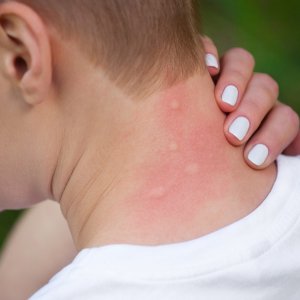Nobody likes getting stung by bees, or bitten by mosquitos, but for those allergic, the experience can be more than just unpleasant, it can be deadly. Here are some tips to help you determine if you are allergic to bug bites.
There are Three Basic Types Of Reactions To Bug Bites
- A normal reaction sets off pain, swelling, and redness around the sting site.
- A large local reaction causes swelling that extends beyond the sting site. For example, a person stung on the ankle may have swelling of the entire leg. While it often looks alarming, it’s usually no more serious than a normal reaction. Large local reactions peak at about 48 hours and then gradually get better over 5 to 10 days.
- The most serious reaction is an allergic one. If you have an allergic reaction to a bug bite, you’ll need to get it treated right away.
Symptoms of Insect Sting Allergies
A mild allergic reaction may cause one or more of these symptoms at the site of the sting:
- Pain
- Redness
- Pimple-like spots
- Mild to moderate swelling
- Warmth
- Itching
Severe allergic reactions (also called an anaphylactic reaction) are not that common. But when they happen, they’re medical emergencies. Symptoms can include:
- Trouble breathing
- Hives that appear as a red, itchy rash and spread to areas beyond the sting
- Swelling of the face, throat, or any part of the mouth or tongue
- Wheezing or trouble swallowing
- Restlessness and anxiety
- Rapid pulse
- Dizziness or a sharp drop in blood pressure
If you experience any of these symptoms seek medical attention as soon as possible.
How Common Are Insect Sting Allergies?
About two million Americans have allergies to the venom of stinging bugs. Many of these people are at risk for life-threatening allergic reactions.
Treatment if You’re Not Allergic
First, if you’re stung on the hand, remove any rings from your fingers immediately.
If stung by a bee, the bee usually leaves a sac of venom and a stinger in your skin. Remove the stinger within 30 seconds to avoid receiving more venom. Gently scrape the sac and stinger out with a fingernail or a stiff-edged object like a credit card. Don’t squeeze the sac or pull on the stinger, or more venom will get into you. Wash the stung area with soap and water, then apply an antiseptic.
Apply a soothing ointment, like a hydrocortisone cream or calamine lotion, and cover the area with a dry, sterile bandage. If the swelling is a problem, apply an ice pack or cold compress to the area.
Finally, you can also take an over-the-counter oral antihistamine to ease itching, swelling, and hives from bug bites. Don’t give this medication to children under 2 years old or to pregnant women unless your doctor says it’s OK. (If you’re pregnant, it’s best to talk to your doctor before you take any medicine.)
Treatment if You Are Allergic
If you have a severe allergic sting reaction, you’ll need epinephrine, which you can inject yourself before you call 911. Usually, this shot will stop a more severe allergic reaction from happening.
You’ll still need emergency medical care, even if the symptoms seem to stop. You may need to stay overnight at the hospital. If you’ve ever had allergic reactions to an insect sting, you should carry epinephrine with you wherever you go.
If you live in South Florida and are having mosquito or no-see-um problems, contact Swat Mosquito Systems to stop the biting and start enjoying your backyard today with a SWAT mosquito mist system.

